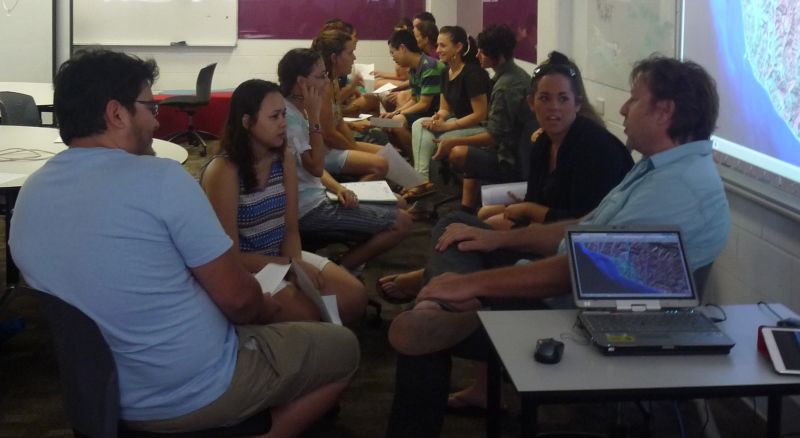So you want to follow the 'flipped classroom' model where you ask the students to do some theory stuff at home first so that you can do some fun stuff in the 'lecture'. Good start.
But here's the most common complaint I hear from colleagues: 'No one is completing my pre-class work!'
Which then leads the colleague to also complain in frustration that they had to spend their in-class time going through the pre-class work and couldn't move on. Otherwise the students would not have understood. What a waste of time for the academic to chaperone students through a reading.
OK, stop right there. If you go through the pre-class work in-class, then the students will NEVER do it before they come to class! You have to set this rule along with your expectations from week 1. You can do this by making the pre-class material for week 1 so simple and brief that the students will do it without thinking. And then in-class have an activity which makes the benefit of having done the pre-class work obvious.
Here's what I do before week 1 starts. I send the students a short survey with some basic questions about themselves. It's easy for them, and they don't feel like they have to get the 'right' answer. This also helps me understand their background and interests, which I can use later. In the survey, I ask them to sign up to the class discussion site. When they come to class, if they haven't signed up, then they lose their mid-lecture break as they have to catch up in this time. This is harmless and doesn't impact on my lesson planning, but sends the message that I expect the pre-class work to be done for a reason. They need to see value in it.
In subsequent weeks, the pre-class work is more content based. I simply assume that it has been done and don't rehash any of it at all. If a student has not done the work, they quickly learn that they will have a hard time understanding. I only go over the pre-class work if I have identified a consistent mis-understanding through the class answers.
Of course the other incentive I use is to allocate a small portion of the class grade to a 'reasonable' attempt at the pre-class work.
The other problem with the above complaint is that the academic is frequently assigning a reading from a textbook as pre-class learning. Sometimes even several chapters! For some students, reading might work, but for the vast majority - BORING! Just because you had to read copious amounts of text when you were at uni way back in the day, doesn't mean that your students need to pass through that same right of passage! In your pre-internet era, maybe there weren't a lot of interactive resources available?
Not that we need to pander to every whim and desire of our clients... I mean students... but if they think something is boring, then they are less likely to absorb and apply its meaning. We are therefore failing in our role as educators. So look out for other ways to engage your students. You don't need to create the stuff for yourself half the time - find some good YouTube videos to get started. That's not to say 'don't assign readings' - but just mix it up.
Have a look at the short video below for more of my thoughts about successfully flipping the classroom.
But here's the most common complaint I hear from colleagues: 'No one is completing my pre-class work!'
Which then leads the colleague to also complain in frustration that they had to spend their in-class time going through the pre-class work and couldn't move on. Otherwise the students would not have understood. What a waste of time for the academic to chaperone students through a reading.
OK, stop right there. If you go through the pre-class work in-class, then the students will NEVER do it before they come to class! You have to set this rule along with your expectations from week 1. You can do this by making the pre-class material for week 1 so simple and brief that the students will do it without thinking. And then in-class have an activity which makes the benefit of having done the pre-class work obvious.
Here's what I do before week 1 starts. I send the students a short survey with some basic questions about themselves. It's easy for them, and they don't feel like they have to get the 'right' answer. This also helps me understand their background and interests, which I can use later. In the survey, I ask them to sign up to the class discussion site. When they come to class, if they haven't signed up, then they lose their mid-lecture break as they have to catch up in this time. This is harmless and doesn't impact on my lesson planning, but sends the message that I expect the pre-class work to be done for a reason. They need to see value in it.
In subsequent weeks, the pre-class work is more content based. I simply assume that it has been done and don't rehash any of it at all. If a student has not done the work, they quickly learn that they will have a hard time understanding. I only go over the pre-class work if I have identified a consistent mis-understanding through the class answers.
Of course the other incentive I use is to allocate a small portion of the class grade to a 'reasonable' attempt at the pre-class work.
The other problem with the above complaint is that the academic is frequently assigning a reading from a textbook as pre-class learning. Sometimes even several chapters! For some students, reading might work, but for the vast majority - BORING! Just because you had to read copious amounts of text when you were at uni way back in the day, doesn't mean that your students need to pass through that same right of passage! In your pre-internet era, maybe there weren't a lot of interactive resources available?
Not that we need to pander to every whim and desire of our clients... I mean students... but if they think something is boring, then they are less likely to absorb and apply its meaning. We are therefore failing in our role as educators. So look out for other ways to engage your students. You don't need to create the stuff for yourself half the time - find some good YouTube videos to get started. That's not to say 'don't assign readings' - but just mix it up.
Have a look at the short video below for more of my thoughts about successfully flipping the classroom.


 RSS Feed
RSS Feed
